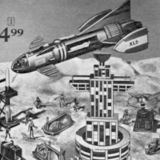I’ve talked about buying the expensive way (completists, and those who must have what they want), and the easy way (just collect what you love). But there’s also a way to collect the CHEAPEST way….and that’s the anarchic way, or –
Buy What Nobody Wants
For a long long time costume jewelry made out of Bakelite was considered “junk.” Just about every garage sale had a box filled with the stuff. Or a table heaped with Five and Dime-store Depression glass. In the Midwest, there used to be tons of it, all bought at Woolworth’s in the 1940s, going begging at 25 cents a plate. Not any more. Sometime in the early 1980s people woke up to “nostalgia” and “charm”. Almost overnight, obscenely garish rhinestone pins and earrings were fun; cheap glass plates in turquoise and pink created a “colorful” display. Nondescript vases, snow domes, lunch boxes, even previously worn hats, aprons and shoes – became objects of value. Nothing was overlooked. From cowboy spurs to tatted or crocheted antimacassars, from barbed wire to buttons, it was all good. And what might have cost $1.25 in 1950 became $85.00 by 1985. And ordinary people started walking around with jeweler’s loupes, checking out the backs and bottoms of anything that could be stamped or signed.

“Collector’s Guides” with pictures and names of objects no one had ever heard of before – let alone dream they should be keeping safe – became necessary. Who wrote the books? All those people who had amassed huge collections of stuff that nobody wanted. And suddenly it had value. The 1980s were filled with “collectibles” guides by Kovel, Warman and Krause. From The Bobbing Head Field Guide (with over 500 color photographs) to collector guides to Hummels, Barbies, and Beanie Babies . . . there was a book for you. How do I know? See my library!
Otherwise sane people began devoting all their Sundays to picking over tables of junk at garage sales (not me. I preferred flea markets and estate sales). It’s getting harder to publish those kinds of books today, but not because people aren’t still interested in identifying and cataloguing their treasures. It’s mainly because publishing PAPER books got too expensive, given the miniscule size of some of these markets. I know, because it took some doing to find those books on Sylvac Pottery. I finally found copies in Australia. 😉

But hey, you can do this, too. Believe it or not (says Ripley) there are STILL untapped lodes of trash that are just waiting to be labeled “treasure.”
You just have to be a risk taker. Because if you are buying items with no proven market value with money that you will need for your retirement, you could be spending your last years in poverty. And I mean this, sincerely….if you happen to be obsessed by something that never achieves marketability. I was always safe, because I’d get nervous if it cost more than $30.00 😉
Go to Google, and search for “crazy collectors” and up will pop a variety of same. Consider the point that the stuff they collect is typically (and relatively) plentiful and cheap – and that even if these collectors can point to collectors clubs for their specialty, and such items are traded daily on eBay – there is no getting around the fact that what they collect is (relatively) “plentiful and cheap” because no one wants it.
I am a living example of this type of collector, when it comes to Ruby and Black Depression glass, Sylvac pottery, and other stuff we don’t know each well enough at this point for me to disclose 😉 Point being that while all the stuff has some ardent admirers, and it’s managed to float high enough in the collectibles universe to merit “collector guides” – they are not (and will likely never be) valuable enough to reach what I call “escape velocity”

Now try Googling a related phrase, “eccentric collectors” – and the same happens. Except that we now have examples of collectors of the obscure and esoteric, and – unsurprisingly, given the adjective “eccentric” – these collectors can afford what is not plentiful and not cheap. But whether the items are expensive or not, I would argue that either class of collector is taking a risk, because the one thing these items have in common is that very few people want them. What happens when it’s time to sell or donate that collection?
Consider the guy who collects “street signs, traffic signs, road signs, etc. plus traffic lights and signals, including most traffic control devices posted by city and state street departments, highway departments or departments of public works in the United States.” You can buy/sell such items on eBay from between $10-$50 each.
Don’t have the room for signs? Surely then you can find room for “Air Sickness Bags” instead? Sound unbelievable? Not to collector Danny Cahalan “a travel agent (who) began collecting air sick bags when he was 21. In an original report, from 2006, he was on South American Paraguauan Airlines and wanted a souvenir but all he could find was an air sick bag. Have you ever felt the same way, and wanted a souvenir of the experience? Well, good news – they’re available on eBay from $1.00 to $25.00 each (up from $1.00 to $12.00 in 2006, when I first started tracking them). And, yes, I mean prices that they SOLD for, not what was asked! That’s a 100% increase in value on the upper end! In only six years!
Putting aside the debatable point that low prices = opportunities, but taking into account that at least some people out there are saving, buying and selling used street signs and “barf bags”, if one of these items were to be offered to you today, in great condition, for less than half the lowest price being paid for any one of them, would you buy it? Why not? Isn’t this a great opportunity?
There are collectors out there putting me to shame. Buying up early examples of pocket calculators, sewing machines, and Circus Giant’s rings – while I’m still working on my small collection of 1950s scatter pins and hankerchiefs. What are the best bets? Stuff that routinely is dumped, destroyed, used up, replaced. The Apple 1 computer sold for $666.66 new, in 1976, and according to Wiki “Only about 200 units were produced (and) as of the turn of the millennium, an estimated 30 to 50 of these are still known to exist, making it a collector’s item . . . An Apple I reportedly sold for $50,000 at auction in 1999”

So: if one of these babies were to be offered to you today, in great condition, for only $40,000, would you buy it? Isn’t this a great opportunity? [hint, trick question]
Contrarians buy when the price is low, and no one wants it, and sell, when the price is high, even when everyone is urging them to hold out, saying “the prices haven’t peaked yet.” But do they necessarily profit any more than those who buy the best examples of things that other people have already deemed worthy of collecting, and keeping them for as long as the objects give them pleasure, irrespective of their market value?
THIS IS A SERIOUS QUESTION. And I would say “no.” It only SEEMS like you could have gotten in “on the ground floor” when you’re looking at results with 20-20 hindsight.
You may be thinking: but isn’t AGE or SCARCITY a requirement for things to be “collectible”? NO. Absolutely NOT. There are huge numbers of things that are, or are getting, old and/or rare that no one cares about or wants. Including my dear Scottie dog scatter pins and “days of the week” embroidered hankerchiefs. I could spend a few blogs on that idea alone. (In fact, I just might, haha ) Just as I could spend equal time listing things that suffer from artificial rarity as the lure to persuade the gullible to purchase them…modern “manufactured” collectibles published in editions purposely kept to levels to encourage the gullible into thinking they are buying something that is naturally scarce and rare. The key to ANARCHIC collecting satisfaction is PASSION. Simply, and only.

Bottom line: buying stuff that’s cheap, either because there’s high supply, or low demand . . . can be fun. And every once in a while collecting that way can earn you the title “visionary”. So long as you don’t mind being called eccentric or crazy along the way, go ahead and enjoy yourself. Have a passion for douche (or enema) bags, monocles/pince nez, or false teeth? These are all things no one uses anymore, or are soon to be things of the past (implants will take over; teeth are usually buried with the wearer). But don’t let me influence you. What do I know? I’m still enjoying my relatively worthless ruby glass.
Betcha didn’t know I was an anarchist! 🙂
Tune in next week for the 5th (and last) Collecting Strategy: Collecting dangerously!











Glad you are enjoying my blog! I haven't done this before, so I have to confess – I'm enjoying this too! As for "ones that got away" – I love reading about these sorts of experiences 😉 They also tend to be very instructive for those who have lived through them (I have one of my own – and I still rue the decision to let myself be persuaded by "reason" not to buy it. So what if we couldn't afford it? ;-)) "My" purchase would have been a measly (heh) $600. back in 1968 (!) And today….$600,000. Sure wish I had ignored my husband! But what can you do? Nothing but educate your eye and learn that sometimes you must take chances….
Jane,
First, I love these posts. Second, I wanted to share something I've learned about collecting, which is trust your gut when you see something interesting.
Back when I was in college, I remember the local bookstore chain (Brentano's I think it was) had a copy of the limited edition of Salvador Dali's Alice in Wonderland, new, for $300, displayed over the cash register. I *almost* bought it.
That book now goes for $20,000 in good (i.e. crappy) condition. If I'd bought it, with my storage habits, the copy would still be mint and easily worth $50,000.
Sure wish I'd trusted my gut…